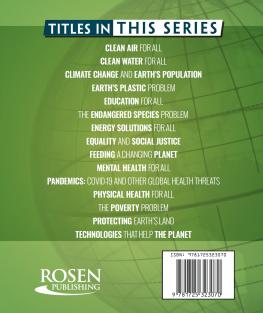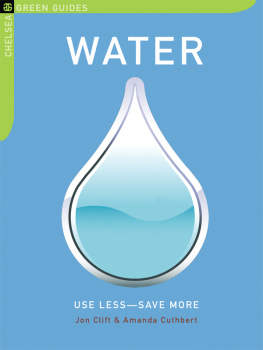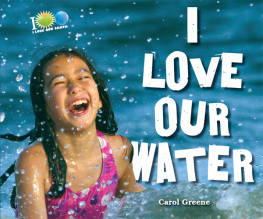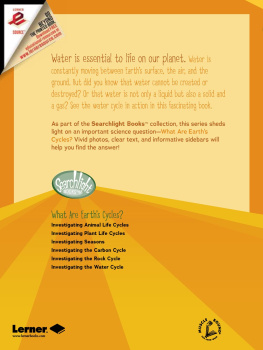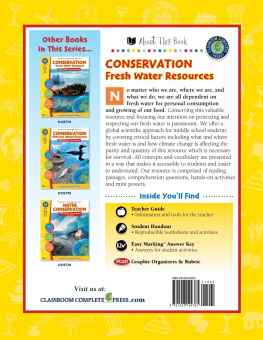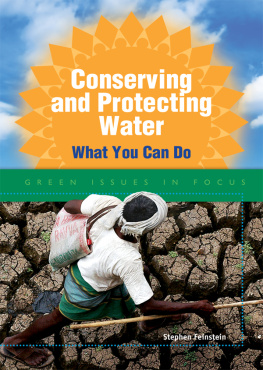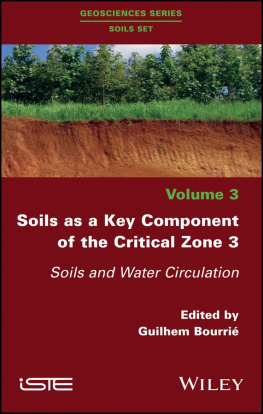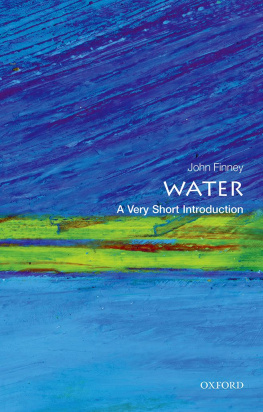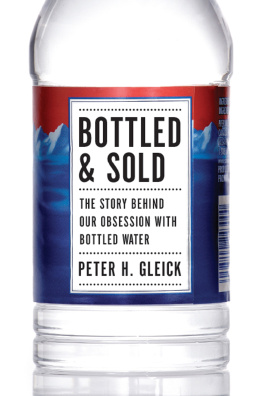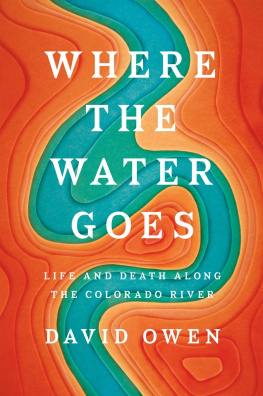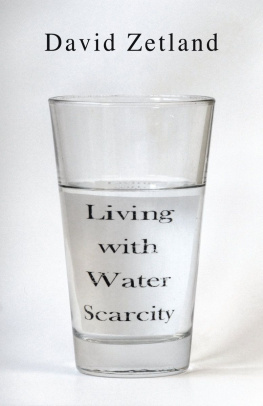written in WATER
MESSAGES OF HOPE FOR EARTHS MOST PRECIOUS RESOURCE
Edited by Irena Salina

Published by the National Geographic Society
1145 17th Street N.W., Washington, D.C. 20036
Copyright 2010 National Geographic Society. All rights reserved. Reproduction of the whole or any part of the contents without written permission from the publisher is prohibited.
Library of Congress Cataloging-in-Publication Data
Written in water: messages of hope for earths most precious resource/Irena Salina, [editor].
p. cm.
Includes bibliographical references.
ISBN: 978-1-4262-0603-0
1. Water--Environmental aspects. 2. Aquatic ecology. I. Salina, Irena, 1968
GB662.3.S25 2009
333.91--dc22
2009046141

The National Geographic Society is one of the worlds largest nonprofit scientific and educational organizations. Founded in 1888 to increase and diffuse geographic knowledge, the Society works to inspire people to care about the planet. It reaches more than 325 million people worldwide each month through its official journal, National Geographic, and other magazines; National Geographic Channel; television documentaries; music; radio; films; books; DVDs; maps; exhibitions; school publishing programs; interactive media; and merchandise. National Geographic has funded more than 9,000 scientific research, conservation and exploration projects and supports an education program combating geographic illiteracy.
For more information, please call 1-800-NGS LINE (647-5463) or write to the following address:
National Geographic Society
1145 17th Street N.W.
Washington, D.C. 20036-4688 U.S.A.
Visit us online at www.nationalgeographic.com
For rights or permissions inquiries, please contact National Geographic Books Subsidiary Rights: ngbookrights@ngs.org
CONTENTS
Peter Gleick
Fishing with the Cucap | Frank Clifford
Cleaning Up the Nashua | Marion Stoddart
Solving Water Shortages Through Ancient Knowledge | Anupam Mishra
Searching for a New Water Ethic | Sandra Postel
Reflecting on a Lifetime of Environmental Reporting | Fred Pearce
Witnessing the Consequences of Kenyas Flower Farms | Maude Barlow
Talking About Sanitation | Rose George
A Short Story | Shekhar Kapur
Breaking Places | Bill McKibben
Taking the Long View at Mount Everest | Alton C. Byers
Monitoring the Miners Canary in the Congo | Melanie Stiassny
Bringing Fresh Water and New Ideas to the Dominican Republic | Ellsworth Havens
Reviving Arid Villages | Rajendra Singh
Traveling the West by Horseback | William Waterway Marks
Building a Charity | Scott Harrison
Teaching Kids to Love Rain Forests | Lynne Cherry
Taxing Yourself | Alex Matthiessen
Recognizing the Importance of the Watershed | Christine Todd Whitman
Defending Water and Place | Jorge Recharte
Reclaiming Our Food | Frederick Kirschenmann
Caring for Watersheds | Dave Rosgen
Safeguarding Water | Kathy Robb
The Ultraviolet Solution to Clean Water | Ashok Gadgil
How We, Like Kalahari Bushmen, Can Trade Our Human Right to Water | James Workman
Stories from a Blue Planet | Alexandra Cousteau
FOREWORD
Peter Gleick
Peter Gleick is co-founder and president of the Pacific Institute for Studies in Development, Environment, and Security in Oakland, California; recipient of the MacArthur Fellows Genius Award and an internationally renowned water visionary.
I VE WORKED PROFESSIONALLY IN WATER for a long timebeginning in the 1970s. But like many of the authors in this collection, my connection to water goes back to long before my professional career, to childhood expeditions exploring the waters of the Pine Barrens of New Jersey, the northern peninsula of Michigan, the inland lakes of Maine. I watched my buttoned-down, pale, officebound lawyer father go off on a two-week river trip riding wooden dories down the Grand Canyon and come back home a bearded, tanned, happy river god. He told me stories of riding the same river and seeing the same ancient canyon walls seen by an earlier one-armed river god, John Wesley Powell, whose own story inspired so many others to work on water. Ive now been down the same stretches of the Colorado River, knowing that decades before my father slept on the same riverbanks, saw those same etched rocks, felt the same sense of awe and wonder over the power of a river. If we protect the river, perhaps my children and their children and more generations will experience that same wonder and awe.
A little bit of oxygen and two little bits of hydrogen. Two of the most basic elements in the universe. Yet they combine to form a magical substance fundamental to life itself: water. We live on a watery planet, unique in our solar system and probably extraordinarily rare in the galaxy. Some have described Earth as the Goldilocks planet. Not too hot, or liquid water couldnt exist, and not too cold, or it would be a frozen wasteland. Just right. And just right it is, with a remarkable combination of water flowing in different forms through different stocks: vast oceans, ice caps, rivers, lakes, water vapor in the atmosphere, and the water that makes up the blood in our veins.
Just as the geological history of the planet can be written in the way the worlds water has ebbed and flowed among these stocks, so too the history of humanity can be written in the different Ages of Water and the way civilizations have understood, managed, and used water. And just as the history of humanity can be written in water, so too can the history of individuals, as the diverse, poetical, and often intensely personal essays in this book show. The power of water has etched the canyons of the planet and the canyons of our souls.
As humans emerged from the fog of evolution, our relationship to water has evolved. The First Age of Water saw simple and serendipitous uses of water. Hunter-gatherer tribes took water from wherever it was available for drinking and cleaning and used flowing water to remove their wastes, where natures biological processes recycled them. If water was bad, or unavailable, people moved or got sick and died, but life was short and brutish already.
The development of agriculture and the establishment of permanent communities began to change our relationship to water, ushering in the Second Age of Water. This age saw the first intentional manipulations of the hydrological cycle to move water from places of abundance to places of scarcity, to control floods and droughts, to separate water supply from wastes, and to treat contaminated water. These technological manipulations have become ever more sophisticated over time, as our engineering, chemical, and physical capabilities, knowledge, and expertise have grown. From the first small earthen or rock dams built in ancient Egypt, India, and Mesopotamia, we now seek to control the largest rivers in the world with huge concrete-and-steel infrastructure. From simple sand filters and the use of chemicals to clean and purify wastewaters, we now have the ability to turn the worst quality wastewaters into the purest drinking water using microscopic membranes, ultraviolet light, ozonation, and other techniques. From simple flooding of agricultural fields using rudimentary canals and hand-dug ditches, we now can accurately measure crop water needs and soil moisture with satellites and neutron probes and apply precise amounts of water to specific areas where and when we want.


